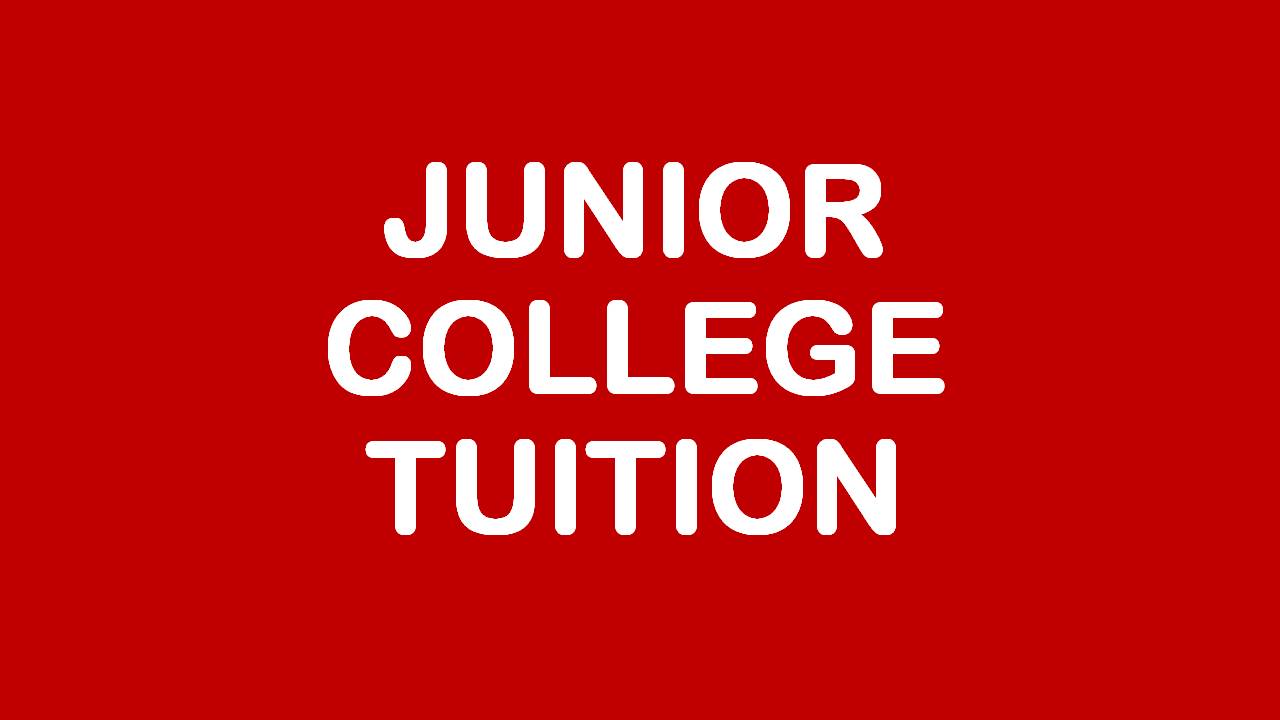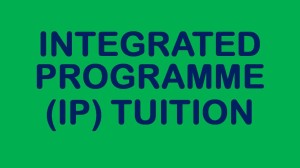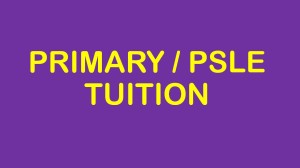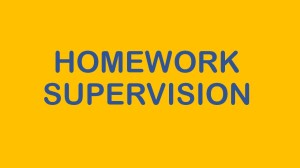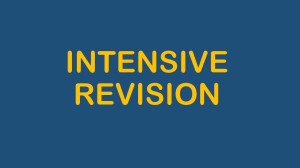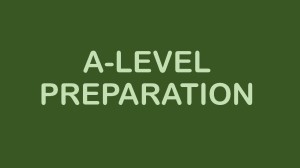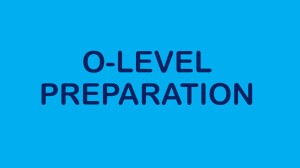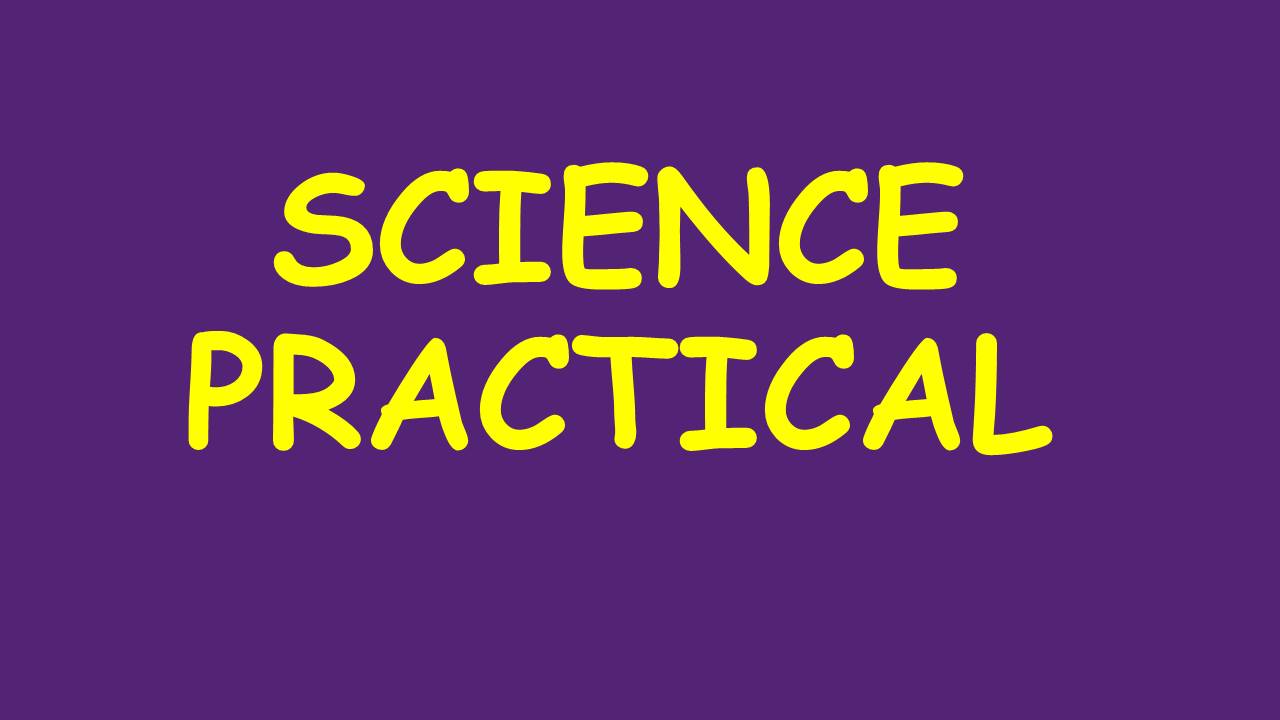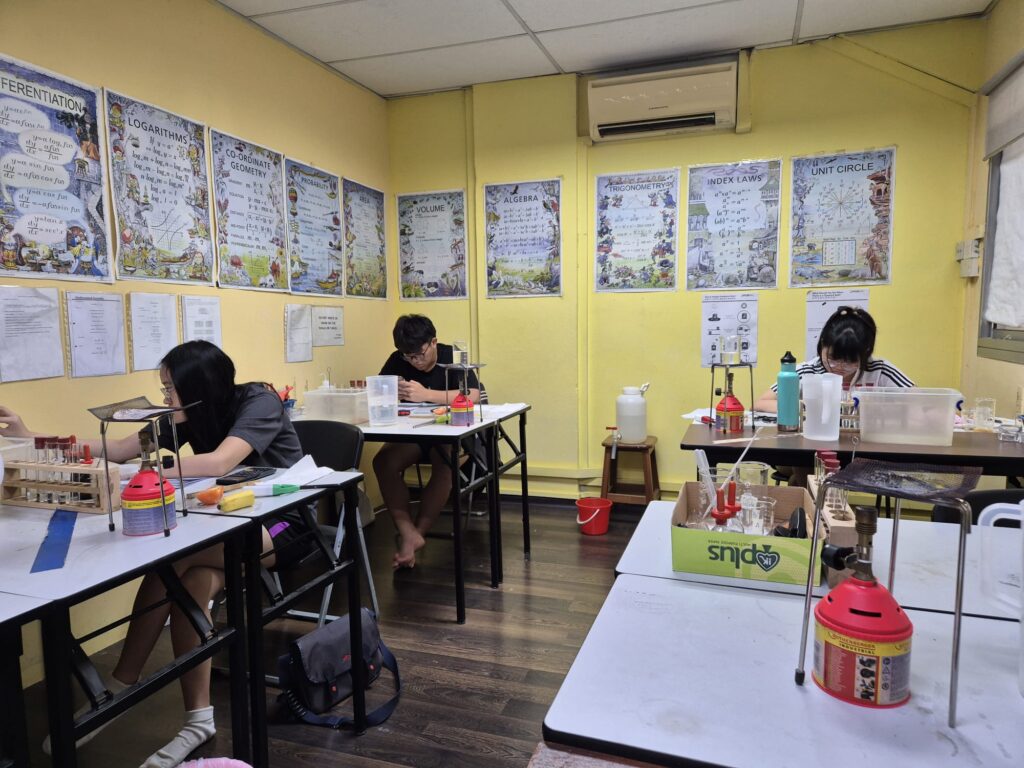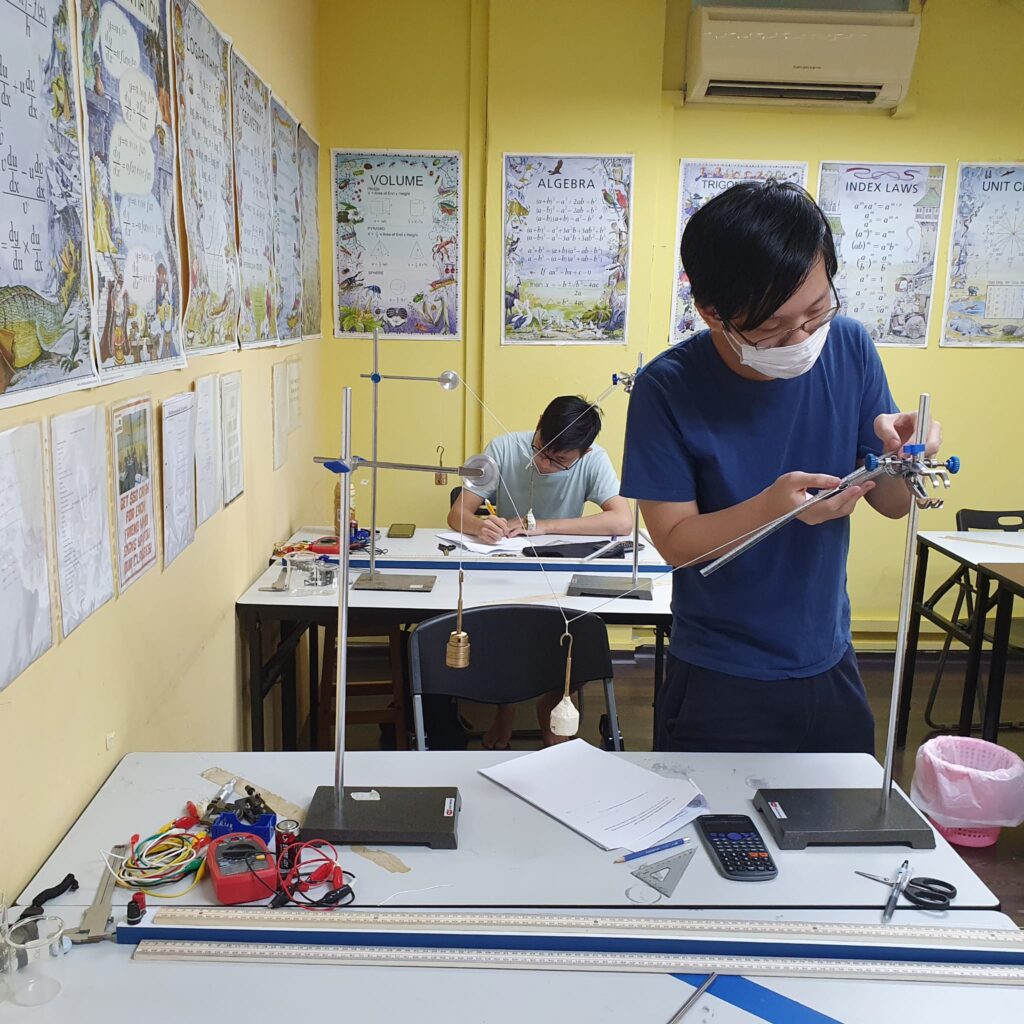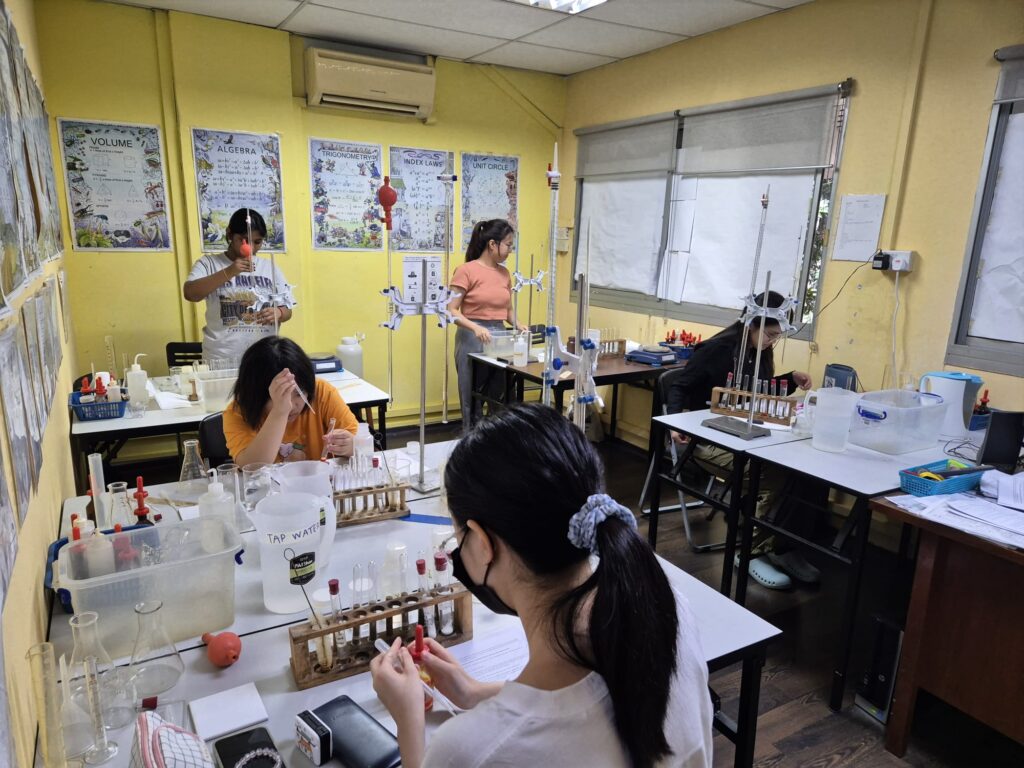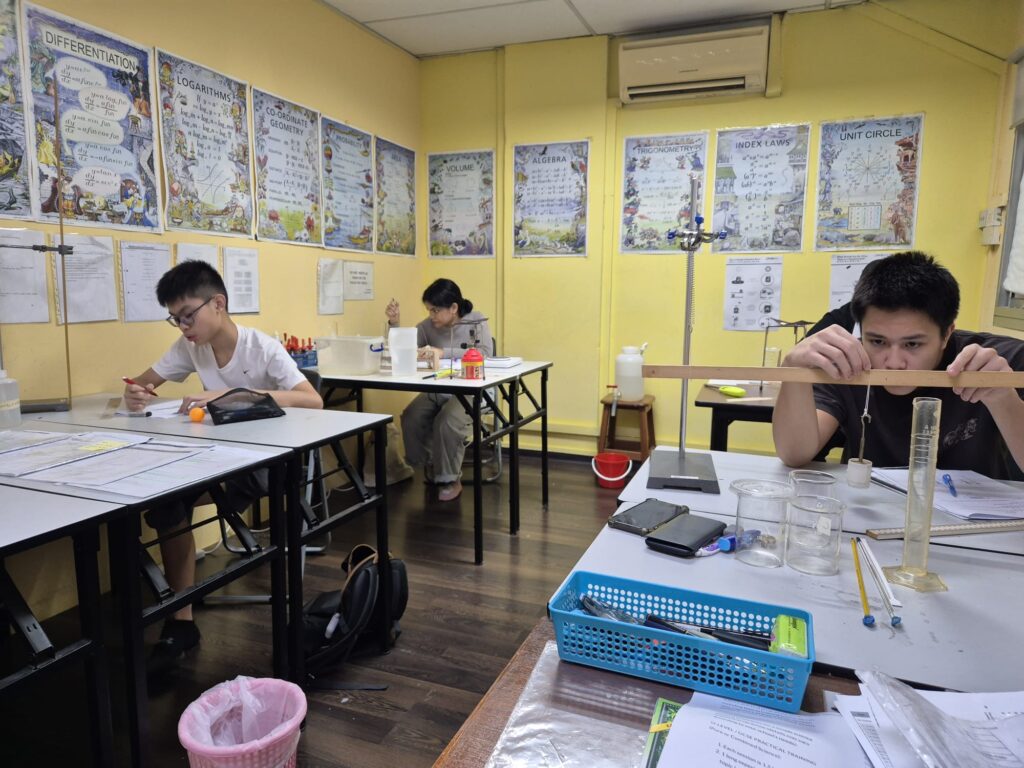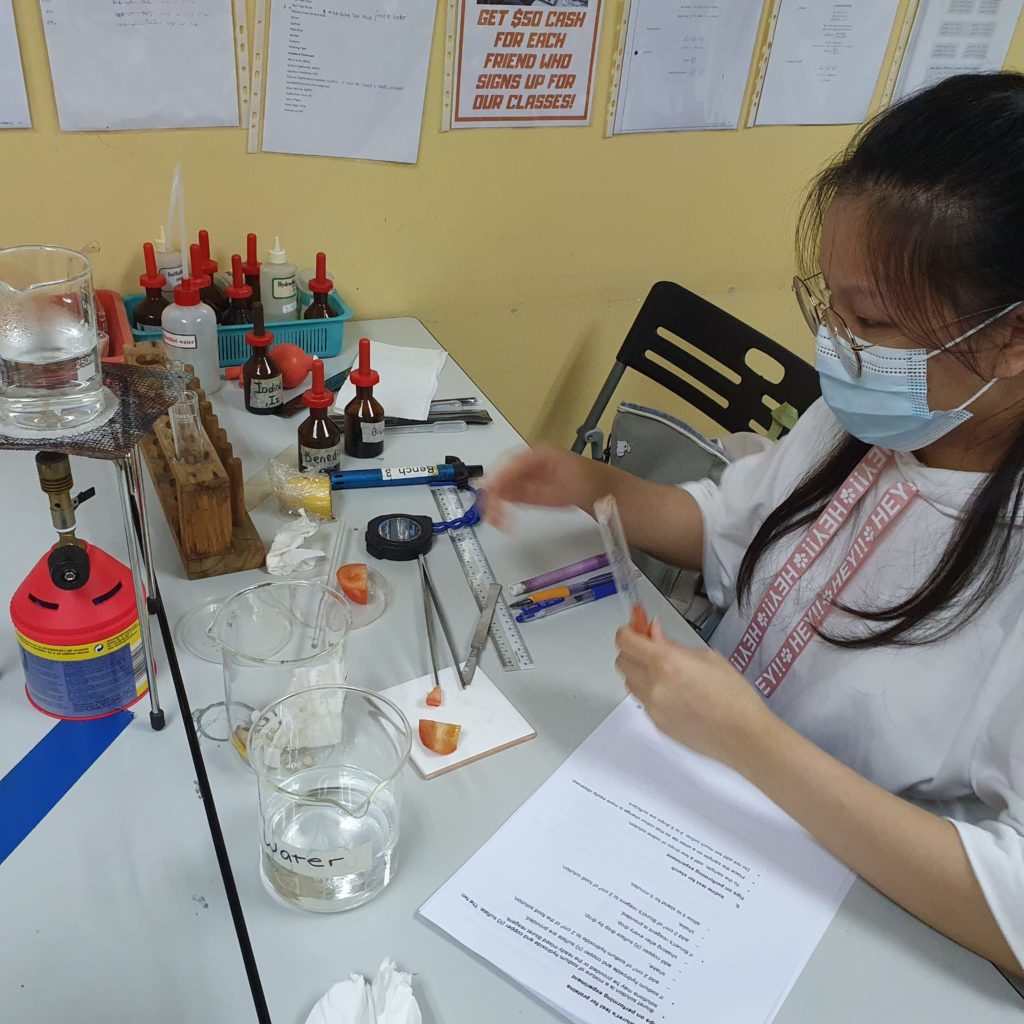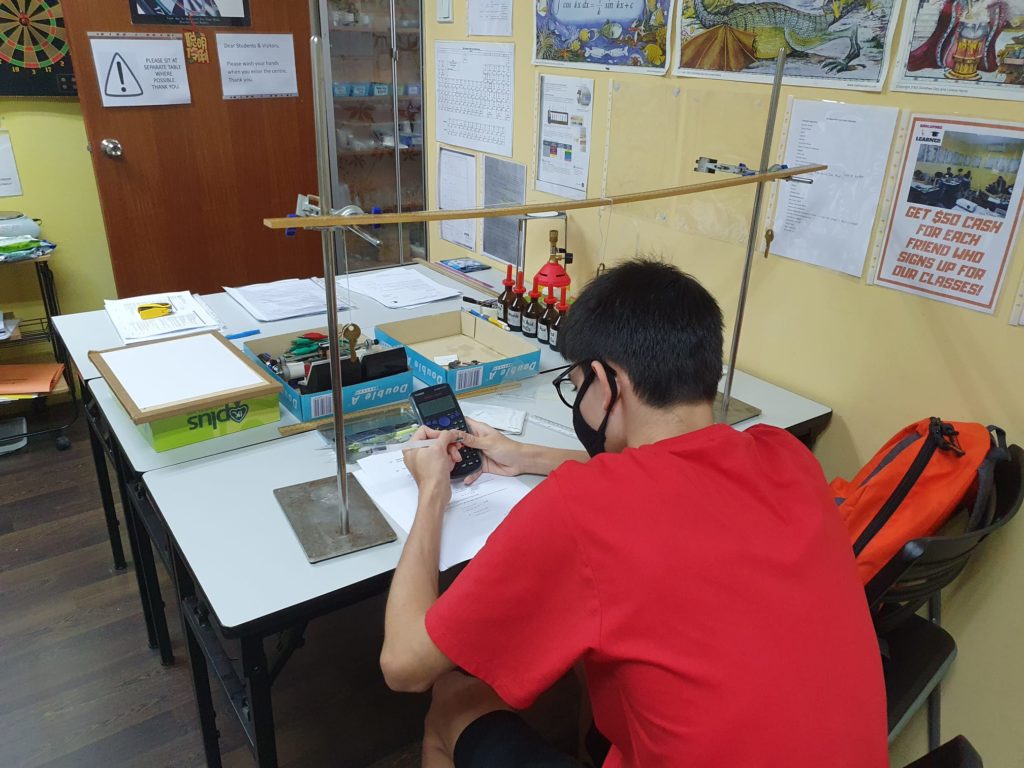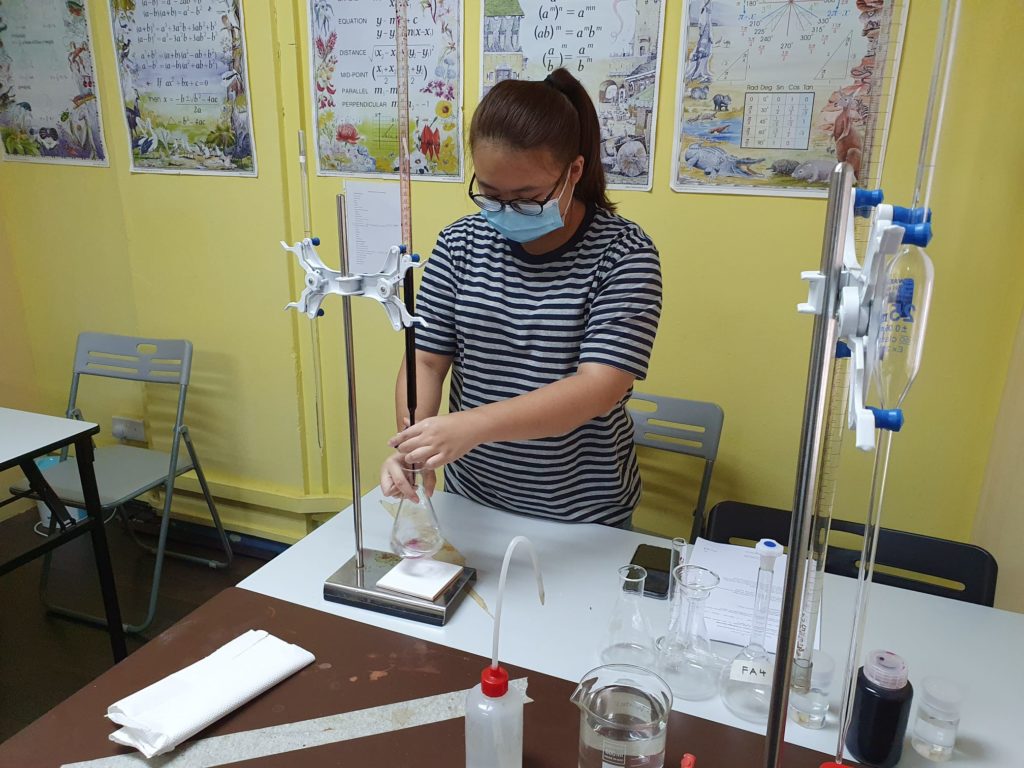Today I taught them the Higher Derivatives, using displacement, velocity and acceleration as real-life examples. I chose not to introduce the 2nd derivative as a means to test whether a turning point is a maximum or minimum, as I preferred to do that when teaching the application of differentiation in tangents and normals at a point in a curve.
Points to note:
(1) students must not write the 2nd derivative as dy^2/dx^2;
(2) d^2y/dx^2 is not the same as (dy/dx)^2;
(3) d^2y/dx^2 is the same as f”(x) or f^2(x);
(4) there may be product rule, quotient rule or chain rule involved when finding the higher derivatives.
Rgds,
Ilyasa, M.Ed, PGDE, ex-MOE Math and Physics teacher (hp: 97860411)
_______________________________________
TUITION CLASSES:
_______________________________________________________________
EDUCATIONAL SERVICES:
______________________________________________________________
By EX-MOE TEACHERS & EXPERIENCED TUTORS
@ BLK 644, BUKIT BATOK CENTRAL, #01-68. S(650644).
CALL 65694897 OR SMS 98530744 OR 97860411.
Sec 4 Chemistry Tuition By Experienced Tutors
For our latest timetable, click here => 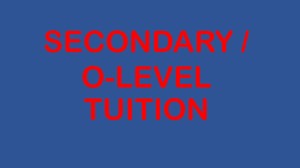
=============================================================
ORIGINAL POST (OUTDATED):
Sec 4 Pure Chemistry: (Investment amt: $180 per mth).
Mon 7.45 pm to 9.15 pm;
Sat 10.45 am to 12.15 pm;
Sun 12.30 pm to 2.00 pm;
Sun 2.15pm to 3.45 pm;
Tutor(s):
Mr Anthony H.: SMU undergrad who scored A for A-level Chemistry
Mr Tan J. D. : NTU undergrad, alumnus of Hwa Chong Institution, who scored A in A-level Chemistry
DETAILS:
Location: Blk 627 Bukit Batok Central #07-640
Average Class Size: 2-5 students
To register, kindly call or send an sms to 97860411, indicating the Student Name, the Subject and Level.
List of ‘Top’ Courses of Polytechnics (2012) in Singapore by net Cut-Off ELR2B2 aggregate
SCIENCE PRACTICAL TRAINING
O-LEVEL PHYSICS PRACTICAL
O-LEVEL CHEMISTRY PRACTICAL
O-LEVEL BIOLOGY PRACTICAL
O-LEVEL SCIENCE (PHYSICS) PRACTICAL
O-LEVEL SCIENCE (CHEMISTRY) PRACTICAL
O-LEVEL SCIENCE (BIOLOGY) PRACTICAL
The table below shows the list of top or popular courses of Polytechnics in Singapore by net cut-off ELR2B2 aggregate. The net ELR2B2 aggregate score includes CCA Bonus Points.
| Course | Course Code | Polytechnics | 2012 JAE COP |
| International Business | N85 | Ngee Ann | 6 |
| International Business | S36 | Singapore | 7 |
| Biomedical Science | S98 | Singapore | 8 |
| Biomedical Science | N59 | Ngee Ann | 9 |
| Veterinary Bioscience | N90 | Ngee Ann | 9 |
| Arts Business Management | N91 | Ngee Ann | 9 |
| Banking & Financial Services | N53 | Ngee Ann | 9 |
| Engineering Science | N93 | Ngee Ann | 9 |
| Psychology Studies | N77 | Ngee Ann | 9 |
| Psychology Studies | T48 | Temasek | 9 |
| Molecular Biotechnology | N49 | Ngee Ann | 10 |
| Tourism & Resort Management | N72 | Ngee Ann | 10 |
| Mass Communication | N67 | Ngee Ann | 10 |
| Biotechnology | S72 | Singapore | 10 |
| Pharmacy Science | N73 | Ngee Ann | 11 |
| Accountancy | N51 | Ngee Ann | 11 |
| Business Studies | N45 | Ngee Ann | 11 |
| Animation & 3D Arts | N92 | Ngee Ann | 11 |
| Film, Sound & Video | N82 | Ngee Ann | 11 |
| Banking & Financial | S76 | Singapore | 11 |
| Business Innovation and Design | S34 | Singapore | 11 |
| Creative Writing for Television and New Media | S41 | Singapore | 11 |
| Biomedical Science | T27 | Temasek | 11 |
| Veterinary Technology | T45 | Temasek | 11 |
| Business & Social Enterprise | N79 | Ngee Ann | 12 |
| Child Psychology & Early Education | N86 | Ngee Ann | 12 |
| Advertising & Public Relations | N87 | Ngee Ann | 12 |
| Chinese Media & Communication | N88 | Ngee Ann | 12 |
| Applied Chemistry with Pharmaceutical Science | S64 | Singapore | 12 |
| Accountancy | S75 | Singapore | 12 |
| Business Administration | S71 | Singapore | 12 |
| Human resource Management with Psychology | S48 | Singapore | 12 |
| Tourism & Resort Management | S55 | Singapore | 12 |
| Aeromautical Engineering | S88 | Singapore | 12 |
| Applied Drama and Psychology | S43 | Singapore | 12 |
| Music & Audio Technology | S97 | Singapore | 12 |
| Accounting & Finance | T02 | Temasek | 12 |
| Aviation Management Services | T04 | Temasek | 12 |
| Accountancy & Finance | C98 | Nanyang | 13 |
| Chemical & Biomolecular Engineering | N56 | Ngee Ann | 13 |
| Hotel & Leisure Facilities Management | N40 | Ngee Ann | 13 |
| Business Information Technology | N61 | Ngee Ann | 13 |
| Aerospace Technology | N65 | Ngee Ann | 13 |
| Optometry | N83 | Ngee Ann | 13 |
| Chinese Studies | N70 | Ngee Ann | 13 |
| Chemical Engineering | S70 | Singapore | 13 |
| Perfumery and Cosmetic Science | S38 | Singapore | 13 |
| Nutrition, Health & Wellness | S44 | Singapore | 13 |
| Financial Informatics | S46 | Singapore | 13 |
| Optometry | S67 | Singapore | 13 |
| Media and Communication | S86 | Singapore | 13 |
| Biotechnology | T31 | Temasek | 13 |
| Communications & Media Management | T40 | Temasek | 13 |
| Law & Management | T09 | Temasek | 13 |
| Early Childhood Studies | T54 | Temasek | 13 |
| Digital Forensics | T55 | Temasek | 13 |
| Banking & Financial Services | C96 | Nanyang | 14 |
| Dental Hygiene & Therapy | C72 | Nanyang | 14 |
| Social Sciences (Social Work) | C47 | Nanyang | 14 |
| Early Childhood Education | N66 | Ngee Ann | 14 |
| Multimedia & Animation | N55 | Ngee Ann | 14 |
| Food, Science & Technology | S47 | Singapore | 14 |
| Architecture | S66 | Singapore | 14 |
| Hotel & Leisure Facilities Management | S95 | Singapore | 14 |
| Integrated Events & Projects Management | S50 | Singapore | 14 |
| Aerospace Electronics | S90 | Singapore | 14 |
| Bioengineering | S58 | Singapore | 14 |
| Infocomm Security Management | S54 | Singapore | 14 |
| Visual Communication and Media Design | S93 | Singapore | 14 |
| Pharmaceutical Science | T25 | Temasek | 14 |
| Aerospace Engineering | T51 | Temasek | 14 |
| Business Intelligience & Analytics | T57 | Temasek | 14 |
| Visual Communication | T24 | Temasek | 14 |
| Medicinal Chemistry | C45 | Nanyang | 15 |
| Pharmaceutical Sciences | C65 | Nanyang | 15 |
| Mass Media Management | C93 | Nanyang | 15 |
| Real Estate Business | N48 | Ngee Ann | 15 |
| Sustainable Urban Design & Engineering | N89 | Ngee Ann | 15 |
| Aerospace Electronics | N75 | Ngee Ann | 15 |
| Audio-visual Technology | N76 | Ngee Ann | 15 |
| Biomedical Engineering | N60 | Ngee Ann | 15 |
| Financial Information | N81 | Ngee Ann | 15 |
| Materials Science | S37 | Singapore | 15 |
| Environmental Management & Water Technology | S52 | Singapore | 15 |
| Engineering with Business | S42 | Singapore | 15 |
| Business Information Technology | S82 | Singapore | 15 |
| Digital Animation | S35 | Singapore | 15 |
| Business/Logistics & Operations Management/ Marketing | T01 | Temasek | 15 |
| Hospitality & Tourism Management | T08 | Temasek | 15 |
| Apparel Design & Merchandising | T20 | Temasek | 15 |
Related Links:
(1) List of ‘Top’ Secondary Schools (2012) in Singapore by median PSLE aggregate score (2011)
(2) List of ‘Top’ Primary Schools (2012) based on GEP classes and Awards achieved.
(3) List of ‘Top’ Secondary School (2012) in Singapore by Cut-Off PSLE aggregate score (2011)
Ilyasa, M.Ed., PGDE, full-time tutor of Math & Physics (h/p: 97860411)
_______________________________________
TUITION CLASSES:
_______________________________________________________________
EDUCATIONAL SERVICES:
______________________________________________________________
By EX-MOE TEACHERS & EXPERIENCED TUTORS
@ BLK 644, BUKIT BATOK CENTRAL, #01-68. S(650644).
CALL 65694897 OR SMS 98530744 OR 97860411.
List of Junior Colleges (JC) (2012) in Singapore by Cut-Off L1R5 aggregate score (including bonus points)
SCIENCE PRACTICAL TRAINING
H2 CHEMISTRY HANDS-ON PRACTICAL CRASH COURSE
H2 BIOLOGY HANDS-ON PRACTICAL CRASH COURSE
H2 PHYSICS HANDS-ON PRACTICAL CRASH COURSE
PRACTICAL CRASH COURSES (Mar, Jun, Sep and Oct)
MOCK EXAMS FOR SCIENCE PRACTICAL (Sep and Oct)
H2 PHYSICS PRACTICAL
H2 CHEMISTRY PRACTICAL
H2 BIOLOGY PRACTICAL
The table below shows the net L1R5 aggregate of the lowest ranked students who were admitted to the Junior Colleges (JCs) through the 2012 Joint Admissions Exercise (JAE).
| S/No | Junior College | Arts | Science/IB |
| 1 | Hwa Chong Institution | 3 | 3 |
| 2 | Raffles Institution | 3 | 3 |
| 3 | Victoria JC | 5 | 4 |
| 4 | National JC | 5 | 5 |
| 5 | Anglo-Chinese School (Independent) | – | 5 |
| 6 | Temasek JC | 7 | 6 |
| 7 | Anglo-Chinese JC | 7 | 6 |
| 8 | Anderson JC | 10 | 8 |
| 9 | Meridian JC | 9 | 9 |
| 10 | Nanyang JC | 9 | 9 |
| 11 | St. Andrew’s JC | 9 | 9 |
| 12 | Catholic JC | 10 | 10 |
| 13 | Serangoon JC | 13 | 13 |
| 14 | Tampines JC | 13 | 14 |
| 15 | Jurong JC | 13 | 16 |
| 16 | Pioneer JC | 16 | 16 |
| 17 | Innova JC | 20 | 20 |
| 18 | Yishun JC | 20 | 20 |
| 19 | St. Joseph’s Institution | – | – |
SCIENCE PRACTICAL TRAINING
H2 PHYSICS PRACTICAL
H2 CHEMISTRY PRACTICAL
H2 BIOLOGY PRACTICAL
Sec 4 Physics Reflections 27/01/13 – Applications of Electrostatics
I wanted to proceed to Current Electricity, but the students wanted more discussion on how to answer application questions on electrostatics.
So I supplied them with quite a number of such application questions, often with confusing diagrams. The key to answering such questions is to first draw the distribution of charges on the items in the diagram, and identify which objects are conductors and which are non-conductors. For the conductors, check whether they are insulated from the surroundings.
Key points to note:
(1) Only non-conductors can be charged by rubbing (why?)
(2) Electrons can flow into and out of only conductors, and only when the conductors are in contact with other conductors (why?)
(3) A charged object can attract a neutral conductor (why?) and a charged object can also attract a neutral non-conductor (why?)
(4) Upon contact with a highly charged object, a conductor behaves differently from a non-conductor (why?)
Rgds,
Ilyasa, M.Ed, PGDE, ex-MOE Math and Physics teacher (hp: 97860411)
=============================================================
For our latest timetable, click here => 
=============================================================
My (our) students’ O-Level (2012) results released in 2013
Ok la, this year I shall break tradition by posting whichever results my last year’s students inform me of. One has just come in. I will update throughout the week as I get more results (sometimes students are just forgetful).
Physics: Luke, A2 (from b4 avg, failed in sec 3 (his mum just told me), St Pat’s sch, Farkhanda, B3 (from fail avg)
Chemistry (under Mr Anthony): Charmaine A2; Bandar A2; Luke, B3; Farkhanda, B4. (from fail avg)
Science: Ben, B3.
A. Math: Ameerul, C5 (from fail avg, Yuhua sec); Loges, B3 (from C5-C6 avg, ACS(I)); Ravin, B3 (from fail avg); Rahim, B3 (from C5-C6 avg); Jin Yong, A1 (from B4 avg); Farkhanda, B3 (from fail avg).
Math: Ali Zul, B3 (from C5-C6 avg); Colin, B3 (from C5)
This year, I shall also break tradition in another way, by posting a testimonial from a student, Ravin. Below is the exact words that he smsed to me at 10.06 am on 11 Jan 2013:
“My plan is to do engineering. More to aerospace or aeronautical. I will put my first few choices as that the rest I’m still thinking. Last choice will be MI. Yes Mr Ilyasa, a lot of improvement. I did not put in a lot of effort for A-math and my sci in secondary school. In fact I was failing but I’m happy to see that I got Bs and A for my math and sci but it’s really disappointing to see a 6 for EL. Thank you for your help Mr Ilyasa. You make lesson so fun and you taught me a lot. : ) “
Well, he taught me a lot too.
Waiting for more updates from more students …..
Ilyasa, M.Ed., PGDE, full-time tutor, ex-sch teacher (h/p: 97860411)
Should N-Level graduates opt for the direct poly route?
From 2013 onwards, top N-Level graduates can go to polytechnics without first having O-Level certificates, either by undergoing a one-year foundation course in the polys for the top 10%, or by doing a Higher Nitec course at the ITE for the next top 20% of their N-Level cohort.
So would it be a wise choice for an N-Level grad to opt for direct entry into a poly, instead of first sitting for the O-Levels? Well, in my opinion, with regard to certification, they face about the same problem as top Express stream students when deciding whether to choose an IP programme or enrol in an O-Level sec school.
An IP student who fails his A-Levels only has a PSLE cert to show, which, despite all the stress it causes, counts for next to nothing. If an N-Level holder fails to get a poly diploma, he would have only his N-Level cert for employment purposes (still sounds better than just having a PSLE cert right?). But I believe many jobs today require at least 3 or 5 O-Level passes. So I think it’s still wise to have an O-Level cert.
However, the O-Level route is a very academic one, and may not suit all N-Level grads, especially those who are weak in English and Mother Tongue. But having a good O-Level cert also allows a student to enter a JC.
So, I think, in the final analysis, whether or not a top N-Level grad chooses to bypass the O-Levels in his quest to enter a poly should depend on whether he believes he can do well in the very theoretical and academic O-Level programme. I’m certain the poly foundation program or the Higher Nitec course has a more hands-on approach to learning and solving problems.
Ilyasa
Related Articles:
O-LEVEL EXAM PREPARATION FOR PRIVATE CANDIDATES
The big jump – from N-Level to O-Level …
I wish all N-level students good results come Monday. But as you know, even if you get good results, it’s just the beginning of another journey. If you intend to do your O-Levels, bear in mind that it’s going to be a rough journey, so you’d need to work extra smart and hard. The O-Levels is tougher than the N-Levels in at least three ways:
(1) Additional topics are added so you’d have to remember more facts and think more, and some of the exam papers are now longer;
(2) The questions in the O-Levels are harder both in intellect and in language use; you’d be expected to write longer answers in proper English for most of the papers;
(3) The marking is stricter for most of the papers. For eg, for the Sciences, you are expected to write proper units for the values you have calculated.
However, preparing for the O-Levels may actually be easier than for the N-Levels as there is much more educational support for the O-Levels – more guide or assessment books, more notes and prelim papers on sale, more tutors willing to coach you etc.
Anyway, I hope that when the N-Level results are released I’ll get a few calls telling me the good news. : )
LOOKING FOR THE BEST PLACE TO DO YOUR SCIENCE PRACTICALS? JOIN US!
We provide A-Level / H2 and O-Level Physics, Chemistry, Biology and Science (Physics/Chemistry/Biology) Practical Training for private / school candidates and homeschoolers, for both local (eg. H2, Singapore-Cambridge) and international exams (CIE, IB, IGCSE).
*Enjoy huge discounts on fees if your lab sessions start in January! Send a message to 88765498 for details.
Why Us?
-
Our teachers are highly qualified and very experienced, and we actually TEACH you good practical techniques.
-
We have been a one-stop comprehensive science practical centre providing solid practical training for ALL THREE sciences and for all levels and streams since 2017.
-
Our laboratory apparatus are exam-grade and the same as those used in MOE schools and our chemicals are all NEA-approved.
-
We have a structured practical training programme catering to the needs of both beginners and experienced students.
-
We have a small class size so that the teacher is able to observe the actions of each student more closely and demonstrate the correct practical techniques where and when necessary.
IMPORTANT INFORMATION FOR PRIVATE CANDIDATES
The registration for ‘A’ and ‘O’ Level exams as a private candidate usually opens around early to mid-April (Please check SEAB website). If you are registering for a Science subject (Physics, Chemistry, Biology or Combined Sciences), at the time of registration in April, you will be asked whether you have done any science practical training in any school, centre, or institute.
Thus if you are considering Singapore Learner as your science practical training provider, you must register with us and begin your science practical sessions for each subject BEFORE APRIL for us to certify that you have attended basic science practical training. Thus it is recommended that you commence practical training with us in Jan/Feb. Please note students usually do about 10 practical sessions per subject to be competent in practicals.
The following is taken from SEAB website:
“If you are registering for a Science subject with a practical paper, you:
• Must have sat the same Science subject(s) previously, OR
• are currently attending or will be attending a course of instruction in Science practical at any institute/school. You must complete the course of instruction in Science practical at the institute/school enrolled in. You are required to declare that you have fulfilled the above requirements at the point of registration. Registration for the subject may be cancelled without a refund of the examination fees if a false declaration is made.“
O-LEVEL PHYSICS PRACTICAL (Jan to Oct)
O-LEVEL CHEMISTRY PRACTICAL (Jan to Oct)
O-LEVEL BIOLOGY PRACTICAL (Jan to Oct)
HANDS-ON PRACTICAL CRASH COURSES (Jun, Sep, Oct)
MOCK EXAMS FOR SCIENCE PRACTICAL (Sep, Oct)
* If instead you are looking for a COMPLETE Science O-Level Prep program (Theory + Practical), then join our SCIENCE ACADEMY.
Note: For training purposes, Pure and Combined Science students attend the same practical sessions as the syllabus for practicals is the same for both. The only difference between the two kinds of practicals is there are no Planning questions for Combined Science students.
HOW TO BOOK A LAB SESSION:
(1) Decide which Program or Lab sessions you need or most suitable for, by visiting the webpages of the practical subjects you are interested in (if you can’t find the labs you want, Whatapps us at 88765498). http://wa.link/w0xxk2
(2) WhatappS or Message our staff at 88765498 with your Name, Private or School Candidate, A or O level, Subject or Lab Name (e.g Lab PP2), Date and Time of Lab. (Our staff will then guide you on how to register and make payment. If you are not sure about the lab sessions, just state your Name and the Subjects and we will get back to you)
(3) Register Online by clicking below:
(4) Pay Registration fee of $50 via Paynow or funds transfer.
(5) Make the required payment for each lab session at least 7 days before the date of the lab session. (You may also pay for several sessions at one go to ensure that you will have a place in future slots)
FEES PER SESSION
Practical Training Session: $190
Mock Exam:- $240
Note: Above fees are subject to changes without prior notice.
Our Practical Centre:
Singapore Learner @ Bukit Batok
Blk 644, Bukit Batok Central, #01-68. S(650644).
Tel: +(65) 6569 4897, +(65) 88765498 (WHATAPPS) http://wa.link/w0xxk2
Email: singaporelearner@gmail.com
If you wish to visit us, kindly call or sms first. Thank you.
Reflections on Sec 4 A. Math class (9/12/2012) …
Two new students joined us ytdy, one from Monfort Sec and one from SCGS. Apparently, I tutored the latter’s cousin a few yrs ago, all the way from Sec 2 to JC2 in Math and Physics, and who is now a first year undergrad; just learnt that he scored 2 A’s and 2 B’s in his A-levels (he might have told me about it); anyway, that proves my point, that you can come from a ‘neighbourhood’ sec sch and then go to a ‘low-ranked’ JC and still do well at the A-Levels. Contrast this with the two ex-IP students that I helped this year to re-take their A-Levels. So students out there pls wake up; no one owes you good grades.
The three tutees agreed to revise some sec 3 topics instead of me teaching them a Sec 4 topic. So for this class (Sat 2.15 to 3.45pm), I will only start teaching Differentiation in Jan 2013. So ydty two of them covered Indices, Surds and Log while the remaining one wanted to revise Trigonometry. Every time, I find joy in proving to students that Logarithms is a VERY EASY topic. Once you understand what a logarithm is, everything about it becomes very easy (I’ve posted another article on Log; pls do a search on it, under A Math study tips I think).
Trigo is a much harder topic, especially the proving of some Trigonometric Identities. However, there are heuristics to use in solving the latter, and these techniques work 95% of the time. I like ‘proving’ qns because there is no answer to find, and students normally dislike such qns precisely because there is no answer to find. But I can’t blame them; imagine spending 6 yrs of your life in pri sch only learning how to find answers, so students become obsessed with finding a numerical answer, and eventually get defeated by qns that ask them to prove something already known.
Related pages:
A. Math Reflections & Study Tips
(1) Simultaneous Equations
Generally an easy topic, but beware of certain kinds of questions such as:
(a) Questions involving reciprocals of x and y, such as
Solve 3(1/x) + 1/y = 1; 1/(x^2) + 1/(y^2) = 5
Ans: x = 1, y = -1/2 or x = -5/2, y = 5/11
Do not make common denominators and cross-multiply; the better technique is to let p = 1/x and q = 1/y.
(b) Questions involving coefficient matrices that are singular (determinant = 0), such as
Given that x and y satisfy the simultaneous equations mx + (m-1)y = 10 and (m-2)x + 3my = 20,
(i) if the equations have no unique solution, find the values of m; (ans: 1/2, -2)
(ii) if the equations have no solution, find the value of m.(ans: 1/2)
(adapted from Additional Math, EPB Panpac, p. 13)
(2) Indices, Surds & Logarithms
Generally an easy topic, except for students who do not understand or memorize the laws of indices and logarithms properly. I find that quite a number of weak students do not know the meaning of logarithm, thus not appreciating and enjoying the topic. Weak students do not realize that while Indices is concerned with the answer or expression obtained when a power is applied to a base number, Logarithms is about the power itself; the power that is needed to be applied to a base to give a certain number.
For eg, why is lg1000 = 3? ‘Evaluate lg1000’ or ‘What is lg1000?’ is the same as asking, “What is the Power that must be applied to the number 10 (the base) to obtain 1000?” Since 10^3 = 1000, therefore the answer is 3.
Weak students almost always make one or more of the following mistakes, thinking that (i) logA x logB = logA + logB, (ii) log(A + B) = logA + logB, (iii) logAB = logA x logB, (iv) (logA)^n = nlogA, (v) logAB^n = nlogAB, (vi) (a^m)^n = a^(m+n). All these are wrong.
How to be good in Indices and Logarithms? READ AND UNDERSTAND THE LAWS OF INDICES AND LOGARITHMS CAREFULLY. Yes, there is such a thing as READING MATH, not just practising Math.
(3) Quadratic Functions & Equations
Some of the points to note are:
(1) Understand that alpha and beta by themselves also satisfy the quadratic eqn because they are the roots of the equation! So it’s not just abt finding the sum and product of roots;
You must be able to solve questions like:
If α is the root of the equation x^2 = 2x – 1, show that α^4 – α^2 = 2α – 2.
(2) Understand that the discriminant (b^2 – 4ac) is less than or equal to zero when the question involves the phrase “for which the function is never positive or never negative”;
(3) Understand that sometimes you are required to solve an inequality involving the discriminant but at other times the inequality involves the function itself;
(4) Understand how to complete the square to determine the maximum or minimum value of a quadratic function;
(5) Recognise that “real and distinct roots”, “real and equal roots”, and “no real roots” have other names that express the same meaning.
TO BE CONTINUED ……….. (by Mr Ilyasa)
===================================================
For our latest timetable, click here => 
